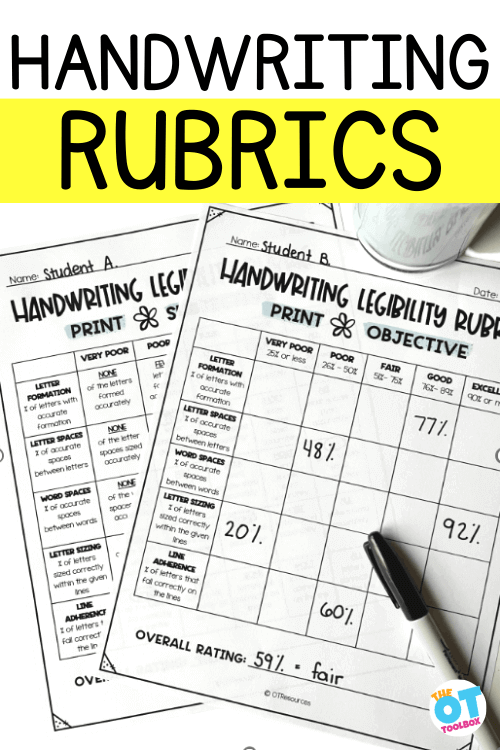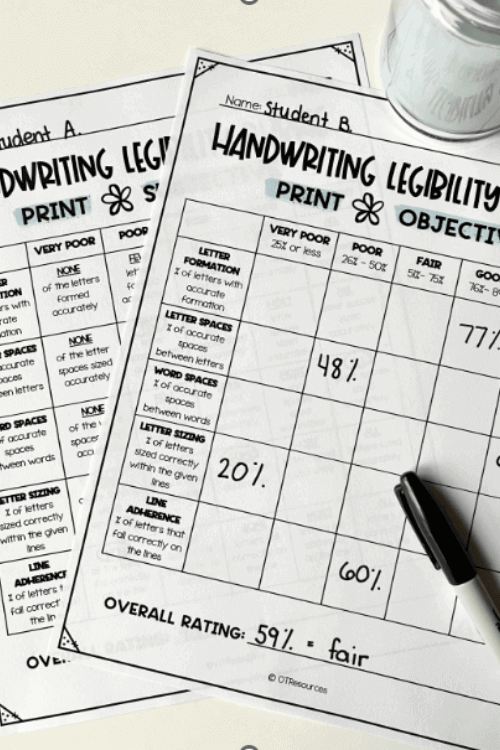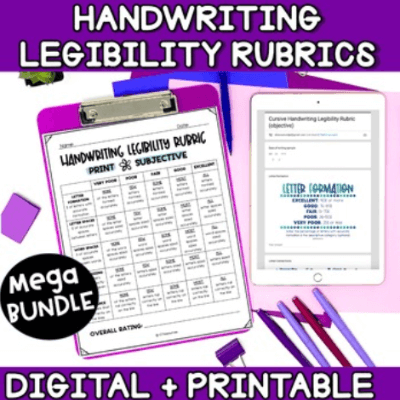In this blog post, you’ll discover how to use a handwriting rubric to collect handwriting data for the IEP, progress reports, and to monitor progress on handwriting goals. When I became a school-based therapist, I was taken aback by the steep learning curve. Honestly, I felt lost for quite some time and it took me a while to get my bearings in the new “IEP world”.

A handwriting rubric is a data scoring tool used to collect and analyze data by outlining specific criteria and performance expectations for assessing handwriting quality.
Handwriting Rubric
It can be hard to translate what we do as occupational therapy practitioners into IEP goals. And, it can be equally as challenging figuring out how to measure progress on those goals you worked so hard to formulate. This might be especially true for handwriting.
If you are looking for guidance on how to collect data on handwriting and to use that data in documentation, you’ve come to the right place. Like it or not, this is a goal area we often spend a lot of time on as pediatric occupational therapy practitioners, and in particular, school based occupational therapy professionals.
Since “IEP world” is so data-driven, using a rubric for handwriting to guide your data collection is a game-changer.
Read on for a step-by-step breakdown on how to step up the data collection game by using a handwriting rubric for progress monitoring.
How to Collect Handwriting Data
Below, we’ll cover the steps of using a writing rubric to collect data. A quick overview of the process is as follows:
- Collect a handwriting sample.
- Select your data collection method (type and format of handwriting rubric tools).
- Fill out the rubric.
- Assess the data to update progress reports and IEP handwriting goals.
Let’s discuss each step of this process in more detail.
Step 1: Get a handwriting sample that meets your goal criteria.
A solid IEP goal should have measurable conditions (the “M” in the wonderful “SMART” acronym). Read about breaking down goals for more information.
I typically do something like “student will self-generate a 4-6 word sentence” or “student will near-point copy 2 sentences.”
If the goal I am reporting on has specifications – it’s important that the data is taken from a sample that meets those criteria! It wouldn’t be a good representation if my data is based on a 3-word sentence, but my student’s goal is to copy a short paragraph.
Your goal may not have a specific condition and that’s OK – just get an appropriate handwriting sample for your student that is a good representation of their abilities.
Step 2: Choose your data collection method (legibility rubric)
During my years of working in school systems, I’ve come up with two tried-and-true handwriting data collection methods. Both are great options, depending on your needs and style.

Handwriting rubrics make collecting data on handwriting goals a breeze.
Types of Handwriting Rubrics
In order to collect data and use that data to write reports, report on handwriting goals, and assess goal achievement, a handwriting rubric can be used to support the OT provider.
There are two types of rubrics for writing skills that you could use:
- Objective Handwriting Legibility Rubric
- Subjective Handwriting Legibility Rubric
It’s also worth mentioning that individual circumstances may help you decide what is the right rubric for you. For example, I tend to use the subjective rubrics more in teletherapy (where it can be harder to get objective data).
Let’s explore each of these types of handwriting rubrics…
Objective Legibility Rubrics
This type of handwriting rubric provides a detailed breakdown of each letter/word of the sample to obtain percentages.
This is the most objective level of data collection. It requires more time and precision, but it will give you hard numbers to work with.
Subjective Legibility Rubrics
This type of handwriting rubric uses terms such as “most”, “some”, “few”, etc. with correlating scale terms “good”, “fair”, “poor”.
This is for therapists who prefer not to get bogged down with detailed numbers, but still provides a consistent and specific rubric in order to be able to adequately demonstrate progress to other team members.
handwriting rubric Formats
Now once you’ve decided on using the objective or subjective rubric, it’s time to decide on your record keeping format. There are two formats that we’re covering here:
- Handwriting Rubric PDF – printable PDF for use with paper and pen
- Digital Handwriting Rubric – online access via a file or Google form
Personally, I am an old fashioned pen-and-paper (or more accurately, pretty colored flair pens) kind of gal. My preferred method of data collection is printing out a legibility rubric, filling it in by hand, and then attaching it to the handwriting sample. I love that when I look back at a students’ file, the sample and hard data are side by side.
If digital paperwork is more your jam, the google forms legibility rubric may be a better fit for you. You simply input your data on the google form, and the magnificent G-suite works its’ magic. You can see all of your data digitally for a nice comparison.
Completing a Handwriting Rubric
After you’ve selected your type and format of writing rubric, the next step is to fill in the handwriting data.
Step 3: Fill out your handwriting legibility rubric based on the collected writing sample.
Here is where we get into the nitty-gritty of handwriting criteria. This is the most time-consuming step. While it is dreaded by many therapists, I personally find it relaxing and cathartic (especially when paired with a nice cup of coffee).
Whether you are using the printable rubric or google forms, your legibility rubric will guide you to break the sample down into the following components:
- Letter formation: how many letters are formed accurately (i.e. they look like the letter they are supposed to look like?)
- Letter spaces: how many of the spaces between LETTERS are an appropriate amount of space (not too close or too far)?
- Word spaces: how many of the spaces between WORDS are an appropriate amount of space (not too close or too far)? Spacing between letters and words is spatial awareness in handwriting.
- Letter sizing: how many letters are the correct SIZE (i.e. tall letters should be bigger than small letters). This is also considered letter size awareness.
- Line adherence: how many letters are placed age-appropriately on the baseline? Also known as line awareness.
For the subjective rubric, you will take the time to really look at the handwriting sample in respect to each category, then make a judgment call based on your professional opinion. If your gut is telling you MOST of the letters are formed accurately, you will circle that category.
By the end, you’ll be able to say that this student has “good” letter formation, “fair” letter spaces, etc.
For the objective rubric, you sit down and do the math calculation. First, add up the total number of items for that category. So, for letter formation, add up the total number of letters. For word spaces, add up the total number of spaces between words.
Then, record the number of letters/spaces that meet expectations. Complete the division problem to obtain your percentage.
At the bottom of each rubric, there is a category for “overall rating”. Just take the average of each individual component to get your overall legibility score. This is super helpful when looking at the big picture of the handwriting sample.
Use a Handwriting Rubric to Update Progress Report
After you’ve collected the data and run it through the writing rubric tool, you can use that data to write your progress report and update goals.
Step 4: Use the data to update student progress over time.
The process may seem tedious, but it does get quicker the more you do it. Once you get the hang of it, it should be a painless process.
It’s important to take these samples a few times per reporting period to make sure you have enough data samples to compare progress. Trust me, you’ll be grateful you did come progress report time!
The Handwriting Rubric Bundle includes printable PDFs and digital Google Drive formats for both print and cursive handwriting.
Handwriting Rubric Bundle
To help out my fellow OTs, I’ve put all these resources together in the Handwriting Legibility Rubric Bundle. It includes both the objective and subjective rubrics in the printable & google forms versions.
Even better, it includes each rubric for both manuscript and cursive! The cursive rubric is essentially the same as print, but it breaks down differently to be more representative of cursive writing (for example, “letter connections” instead of “letter spaces”).
Click here to get your copy of The Handwriting Rubric Bundle.
I hope this writing rubric tutorial has shed light on the possibilities of success using handwriting rubrics. Using these rubrics has made me feel more confident as a practitioner (especially in IEP meetings!), and I hope they do the same for you.
Rachel Burgess, OTR/L is an occupational therapist with 5 years of experience, graduating from Nova Southeastern University in 2018. Rachel currently focuses on school-based services, both in-person and teletherapy.







